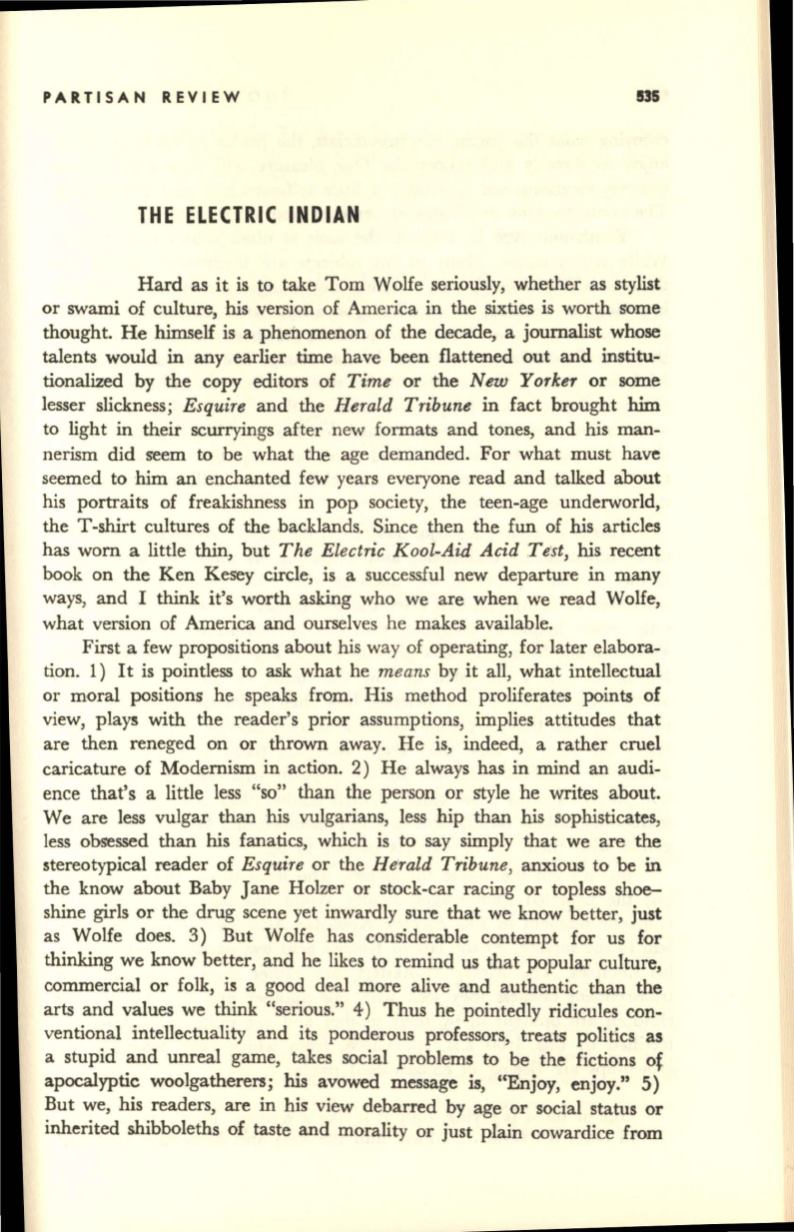
PARTISAN REVIEW
535
THE ELECTRIC INDIAN
Hard as it is to take Tom Wolfe seriously, whether as stylist
or swami of culture, his version of America in the sixties is worth some
thought. He himself is a phenomenon of the decade, a journalist whose
talents would in any earlier time have been flattened out and institu–
tionalized by the copy editors of
Time
or the
New Yorker
or some
lesser slickness;
Esquire
and the
Herald Tribune
in fact brought
him
to light in their scurryings after new fonnats and tones, and his man–
nerism did seem to be what the age demanded. For what must have
seemed to him an enchanted few years everyone read and talked about
his portraits of freakishness in pop society, the teen-age underworld,
the T-shirt cultures of the backlands. Since then the fun of his articles
has worn a little thin, but
The Electric Kool-Aid Acid Test,
his recent
book on the Ken Kesey circle, is a successful new departure in many
ways, and I think it's worth asking who we are when we read Wolfe,
what version of America and ourselves he makes available.
First a few propositions about his way of operating, for later elabora–
tion. 1)
It
is pointless to ask what he
means
by it all, what intellectual
or moral positions he speaks from. His method proliferates points of
view, plays with the reader's prior assumptions, implies attitudes that
are then reneged on or thrown away. He is, indeed, a rather cruel
caricature of Modernism in action. 2) He always has in mind an audi–
ence that's a little less "so" than the person or style he
writes
about.
We are less vulgar than his vulgarians, less hip than his sophisticates,
less obsessed than his fanatics, which is to say simply that we are the
stereotypical reader of
Esquire
or the
Herald Tribune,
anxious to
be
in
the know about Baby Jane Holzer or stock-car racing or topless shoe–
shine girls or the drug scene yet inwardly sure that we know better, just
as Wolfe does. 3) But Wolfe has considerable contempt for us for
thinking we know better, and he likes to remind us that popular culture,
commercial or folk, is a good deal more alive and authentic than the
arts and values we think "serious." 4) Thus he pointedly ridicules con–
ventional intellectuality and its ponderous professors, treats politics as
a stupid and unreal game, takes social problems
to
be the fictions of
apocalyptic woolgatherers; his avowed message is, "Enjoy, enjoy." 5)
But we, his readers, are in his view debarred by age or social status or
inherited shibboleths of taste and morality or just plain cowardice from


